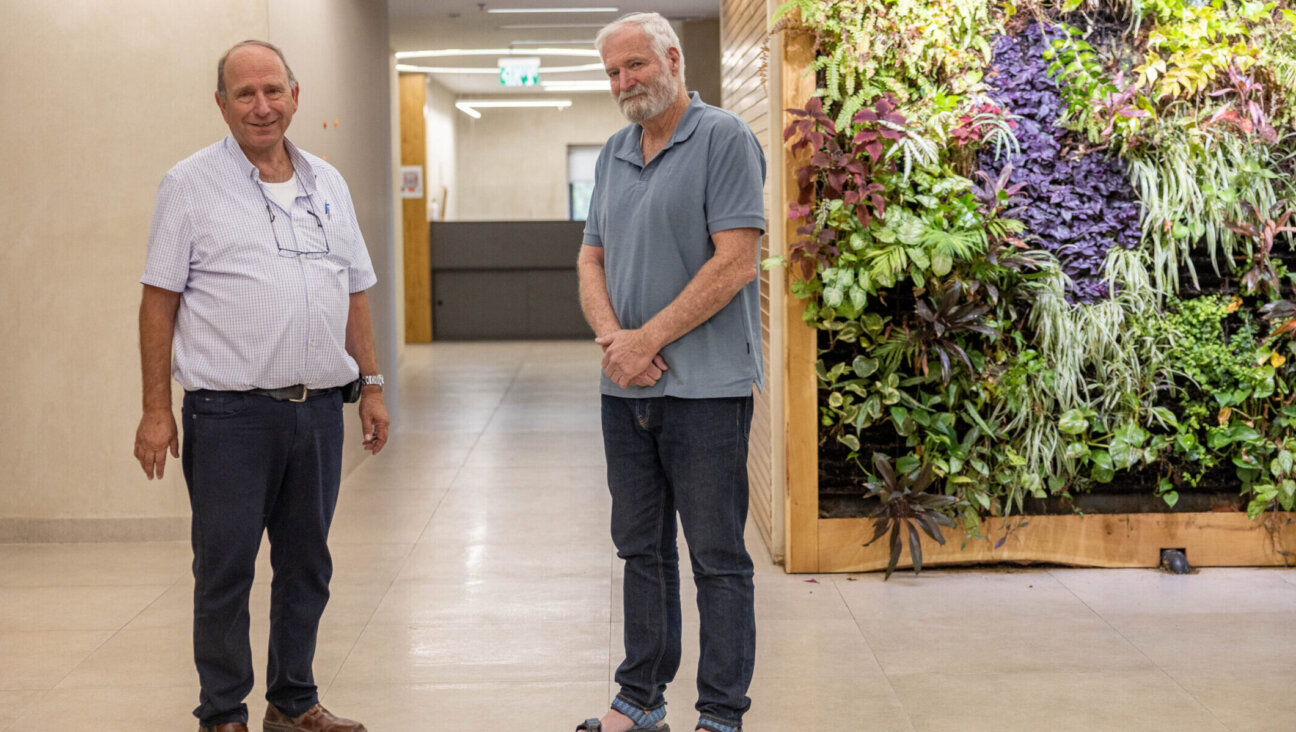For Tradition’s Sake: One Reform Temple Cleaves to Sunday Services
At the beginning of the week’s main service at the Chicago Sinai Congregation, Rabbi Michael Sternfield cheerily wished those present a “good Shabbes,” but immediately caught himself. It being Sunday, when Sinai’s central service takes place, Sternfield turned to a more appropriate greeting:. “I mean good morning,” the rabbi corrected himself. “I am programmed, aren’t I?” he asked, a touch of bemusement in his voice.
The Sunday service has become such a relic within the Reform movement that even Sinai’s rabbi sometimes has trouble keeping it straight. This was not always the case. Seventy years ago, worshiping on Sundays was commonplace in urban Reform synagogues like Sinai, which stands just blocks from the 100-story John Hancock Center tower in downtown Chicago.
Since the 1950s, and particularly in the past decade, the Reform movement has shifted away from the religious stream’s 19th-century innovations, instead favoring a greater adherence to traditional, Torah-based Judaism. A few synagogues, like Sinai, have retained the practices of historical or classical Reform Judaism, with its rejection of yarmulkes and prayer shawls. Yet at even the most die-hard classical Reform temples, the Sunday service has faded away.
As a result, Sinai, where the Sunday service has become an entrenched and cherished tradition in and of itself, is emerging as an exception to the developing rule of Reform practice.
“It is so much a part of the pattern of this congregation,” Sternfield said of the Sunday services. “It would have been unwise to try and abandon it when I arrived in 1995.”
The numbers drawn to Sinai’s Sunday service have dwindled in recent years, while attendance has grown at Friday night and Saturday services, which the congregation has always held. But the gatherings on Sunday mornings remain a symbol of the synagogue’s continuation of a larger set of 19th-century innovations.
This particular innovation came about in the 1870s, before the five-day workweek, when many city-dwelling Jews were unable to take Saturdays off of work. The problem was fittingly reflected at one service held in the late 19th century at Boston’s largest synagogue, Temple Israel, when the rabbi looked out to see a congregation of 14 women and seven children.
To combat dropping attendance, Reform congregations adapted to the worship patterns of the Protestants around them, holding the week’s largest services on Sundays. Sinai was one of the first Reform synagogues to do so, holding its initial Sunday service about a decade after its founding.
“It wasn’t a move away from Shabbat,” said Rabbi Lawrence Hoffman, an expert in Jewish liturgy and ritual at Hebrew Union College. “It was a way to save Jewish religious experience for people who were having less and less.”
These services never purported to be Sabbath services — the service at Sinai follows Judaism’s standard weekday order of worship — but they quickly became immensely popular. Free from the more rigorous Sabbath worship schedule, Reform rabbis used their Sunday services as a time to focus on adult education. The famous Rabbi Stephen Wise of the Free Synagogue in New York used to hold Sunday services at Carnegie Hall, during which he addressed an ocean of topics.
At Sinai, Sternfield’s recent sermon was an educational one in which he spoke of the shifting meanings of the yarmulke and prayer shawl within the Reform movement. Sternfield said Sundays provide a rare opportunity for delving into such matters in any depth.
“Sunday mornings are a quiet time that naturally can be used for spiritual and religious pursuits,” Sternfield said. “It’s maybe the only opportunity in the whole week where we can attract everyone without having to compete with everything else in downtown Chicago.”
The big draw, though, has always been convenience, and Sternfield’s congregants say this is still the case.
“It’s striking how much it is still true that it is easier to find time on Sunday,” said John Tingley, who has belonged to the Chicago Sinai Congregation for 20 years. “There is a definite slowing-down on Sunday.”
With the 20th century and Jewish flight to the suburbs came new innovations. But Saturdays continued to be a problem —
with soccer games and youth hockey — so suburban congregations came up with the late-Friday-evening service, which parents could attend after work. This also, of course, allowed rabbis to hold their main worship services on Shabbat.
“We now desperately want to re-create Shabbat for Shabbat’s own sake and avoid any appearance of doing something for convenience,” Hoffman said.
The Sunday service is but one of the innovations that Reform Jews have turned away from since World War II. The spirit of those earlier reforms was contained in the Pittsburgh Platform of 1885, which rejected “all such Mosaic and rabbinical laws as regulate diet, priestly purity, and dress.”
Today, however, Mosaic garb like prayer shawls is commonplace at Reform synagogues across America. In 1999, the Reform movement’s Central Conference of American Rabbis adopted its “Statement of Principles for Reform Judaism,” which affirmed “the language of Torah and Jewish liturgy, that we may draw closer to our people’s sacred texts.”
Sinai and a small cadre of other Reform synagogues — mostly in the Midwest and South, but also including Temple Emanu-El in New York, the largest Reform congregation in the world — have kept a careful distance from this neo-traditionalism.
“All of the movements of Judaism have been moving in a retrogressive direction — moving toward more and more traditional practices,” Sternfield said. “I don’t have a problem with traditions like eating kosher — if there’s a rational reason. But to add a lot more Hebrew to the service, and to chant it, and not even know what the meaning of the text is, is like singing nonsense syllables. Just because it’s what Jews do is not a sufficient answer.”
Sternfield argues that Sinai and other classical Reform synagogues are upholding the foremost principles of 19th-century Reform Judaism: rationality and modernity. In this spirit, Sternfield has helped create a liberal, forward-looking congregation that welcomes interfaith and same-sex couples with open arms. This has made for a young, dynamic congregation that has quadrupled in size during the past six years to more than 750 families.
But in moving forward, Chicago Sinai has maintained its own stable of traditions — it’s just that most of them come from 100 years ago rather than 3,000 years ago.
While the rest of the Reform movement has abandoned the Union Prayerbook, Sternfield has revised it for his congregants.
And then there is the Sunday service, which is showing its age these days. The piano-player and the daughter of the congregation’s president were the only people under 40 at the synagogue on a recent Sunday. The highlight of that service was the 90th-birthday celebration for Bea Fox, who has been at Sinai so long that she says she can’t remember when she started attending.
Tingley admitted that, even at Sinai, if the Sunday service did not already exist, it would be difficult to start it up now. But, he said proudly, “we have our own tradition to refer to.”
A message from our CEO & publisher Rachel Fishman Feddersen

I hope you appreciated this article. Before you go, I’d like to ask you to please support the Forward’s award-winning, nonprofit journalism during this critical time.
We’ve set a goal to raise $260,000 by December 31. That’s an ambitious goal, but one that will give us the resources we need to invest in the high quality news, opinion, analysis and cultural coverage that isn’t available anywhere else.
If you feel inspired to make an impact, now is the time to give something back. Join us as a member at your most generous level.
— Rachel Fishman Feddersen, Publisher and CEO






















